I posted this on the general form but really it belongs here. I got this Cremanthodium as C. delavayi. It took 4 years to bloom and boy what a cluster! Anyone want to attempt to give it a name?
Comments
Re: Cremanthodium ID
The plant is a little over 2 feet tall. They are not nodding...rather they are outward facing. I've grown three species from seeds but the tags got lost. The others have yet to bloom. The seeds were ellisiae, delavayi and arnicoides...yet this one does not seem to match either of them.
Re: Cremanthodium ID
I'd guess that the plant is C. ellisiae, but Chris Chadwell is here in MA this weekend, and will be staying with Mark McDonough over the weekend, and he certainly can identify it. Hopefully Mark gets on the Forum tonight or tomorrow.
Re: Cremanthodium ID
It might help to compare the leaves and the line drawing of said "Cremanthodium delevayi":
Line drawing of Cremanthodium delavayi (3-5):
http://www.plants.csdb.cn/eflora/Photo/ORGFLORA/77%282%29-151.jpg
Line drawing of Cremanthodium arnicoides (6-8):
http://www.plants.csdb.cn/eflora/Photo/ORGFLORA/77%282%29-158.jpg
Other Cremanthodium
Red Cremanthodium
http://flower.onego.ru/anpine/en_2051.jpg
Pink Cremanthodium rhodocephalum (Tibet)
http://www.jansalpines.com/gallery/main.php?g2_itemId=8276
Cremanthodium ellisii (Tibet, 5150 m)
http://www.jansalpines.com/gallery/main.php?g2_itemId=17367
http://www.jansalpines.com/gallery/main.php?g2_itemId=17190
Cremanthodium decaisnei (Tibet, 5180 m)
http://www.jansalpines.com/gallery/main.php?g2_itemId=17160
Re: Cremanthodium ID
Chris Chadwell has viewed your photographs and isn't certain which one it is, if it's actually a Cremanthodium. Do you happen to recall the source of the seed? It may be easier for him to identify it if he knew from whence it came.
Re: Cremanthodium ID
Chris Chadwell has viewed your photographs and isn't certain which one it is, if it's actually a Cremanthodium. Do you happen to recall the source of the seed? It may be easier for him to identify it if he knew from whence it came.
My guess is that the plant is not a Cremanthodium; maybe a Helianthus species?. When Chris, his son Matthew, and I visited the Kris Fenderson garden, we saw a rather similar looking "sunflower" that Kris said came to him as a Cremanthodium but all agreed it clearly was not... his plant was taller, about 3' or more.
The reason I posted a number of photo and drawings links of Cremanthodium was to give an idea about what members of this genus look like; with the nodding disposition to the flowers a unifying characteristic.
Re: Cremanthodium ID
It is most certainly a Cremanthodium...the cauline leaves clasp the stem...never seen a Helianthus do that! The basal leaves looks much like ellisiae. The seeds came from the Reykjavik BG.
Re: Cremanthodium ID
It is most certainly a Cremanthodium...the cauline leaves clasp the stem...never seen a Helianthus do that! The basal leaves looks much like ellisiae. The seeds came from the Reykjavik BG.
Can we see a photo or two of the foliage and the whole plant? The plant doesn't look much like the two photo links I posted above, from Harry Jans' entries for Cremanthodium ellisii (note spelling) taken in Tibet.
Link to a SRGC photo of Cremanthodium ellisii:
http://www.srgc.org.uk/pport/Cremell.html
More Cremanthodium ellisii links:
http://www.flowersofindia.in/catalog/slides/Himalayan%20Mini%20Sunflower...
http://photos.v-d-brink.eu/Flora-and-Fauna/Asia/Pakistan-Karakorum/10569...
http://photos.v-d-brink.eu/Flora-and-Fauna/Asia/Pakistan-Karakorum/10569...
http://www.kew.org/news/kew-blogs/alpine-rock-garden/katie-visits-munich...
Re: Cremanthodium ID
The images do seem to match a Cremanthodium. Sorry but Cremanthodium is a difficult genus identification-wise. Some species used to be included within Ligularia and Senecio......
The images do not match any Himalayan species I am familiar with, though I have not seen all the Eastern Himalayan ones in flower. It comes closest to Cremanthodium arnicoides.
Given that the seed arrived as Cremanthodium delavayii, along with its general appearance, my current thinking is that it might be a species from SW China. Does anyone have a copy of HIMALAYAN PLANTS ILLUSTRATED by Toshio Yoshida? Can they check the illustrations of Cremanthodiums there - this massive book, includes SW China (I separate the Himalaya from SW China) to see if anything looks similar. I could then comment further.
Did the seed arrive with a reference or collection number? Who assigned the original name Cremanthodium delavayii? Where did the botanic garden in Iceland get the original seed from? If it was from genuine wild provenance, there should be collector's initials and number - then the person/expedition which collected it in China (or wherever) could be contacted, as they may have an update as to identification.
The images of Cremanthodium ellisii posted most recently by Mark do match my understanding of the species in the W.Himalaya incl. the SRGC one which was raised from Chadwell & McKelvie seed but those from Hary Jans do not but they could be a Tibetan (i.e. rain-shadow) extreme-elevation, scree-dwelling variant?
Re: Cremanthodium ID
Welcome back Chris (to this side of the virtual pond, that is) glad to see you here and learn of your insights on Cremanthodium. To add further clues, I almost forgot about my copy of Flowers of the Himalaya by Oleg Polunin and Adam Stainton. In fair use provisions, I scanned a couple pertinent images of various Cremanthodium, and post them hear. Regarding the possibility of the subject plant of C. ellisii, this is a single flowered species (one flower per stem), as can be seen in the good photo. The reason I asked Todd to see the foliage, it seems that Cremanthodiums have bold and distinctive foliage, so seeing a photo of the foliage would certainly help.
Three more species, with the hallmark nodding flowers, C. nepalense, C. oblongatum, and C. reniforme.
Lastly, C. arnicoides, with a spike of flowers, perhaps the closest in appearance to Todd's plant, but I'm still not deliberating on it until we see the foliage and more details.
Chris, you wouldn't like the heat here today (and nearly everyday this July so far), 94 degrees was the high (34 C). Are there various Cremanthodium species that you anticipate collecting in your seed collecting trip this year to the Himalaya? if anyone is interested in getting seeds of the real McCoys, having your NARGS Chapter buy a share of Chris' upcoming expedition seed sounds like a worthwhile adventure, or perhaps buy a share yourself, or "share a share" with a friend or two. :D
Re: Cremanthodium ID
Hot is was! Mark, since we're discussing Cremanthodiums, I found out what that huge leafed plant I had in the small garden in front of my porch actually is. I gave one seedling to a neighbor gardener, and she's grown it out. It's about 5 feet tall, and is a rather attractive Inula. Chris has seen it, and perhaps he can recall exactly which one. But it IS garden worthy, but not ROCK garden worthy.
Re: Cremanthodium ID
Hot is was! Mark, since we're discussing Cremanthodiums, I found out what that huge leafed plant I had in the small garden in front of my porch actually is. I gave one seedling to a neighbor gardener, and she's grown it out. It's about 5 feet tall, and is a rather attractive Inula. Chris has seen it, and perhaps he can recall exactly which one. But it IS garden worthy, but not ROCK garden worthy.
Ah ha, I was wondering what that monster was! Several attractive Inula species are pictured in Flowers of the Himalaya, all but one are smaller plants, Inula racemosa is the only tall one listed, growing to 1.75 m (over 5'), although there's no illustration of it in the book. Here's a web link to a photo said to be Inula racemosa:
http://www.esveld.nl/htmldiaen/i/inrson.php
...and an image from Jelitto:
http://www.jelitto.com/english/IA074.x.htm
Re: Cremanthodium ID
During my Fall Expedition to W.Tibet/ NW Himalaya, I expect to gather seed of Cremanthodium ellisii (boasting a delightful scent) from wet ledges growing with Meconopsis aculeata and probably miniature Cremanthodium decaisnei. There is a possibility of locating Cremanthodium arnicoides, more typically found in the E.Himalaya and even Cremanthodium nanum - which inhabits screes up to 5700m!
This is my second ever post. Once my eldest son (who acts as my IT consultant, since I find embracing modern technology a painful experience) shows me how to attach pictures, I intend to post images of an Inula growing in the garden of Kris Fenderson in NH (author of A SYNOPTIC GUIDE TO THE GENUS PRIMULA), which arrived as Cremanthodium arnicoides - Mark McDonough had generously driven me to an open day there whilst hosting me earlier this month.
I also have an image of what may prove to be the same plant, grown by a Cremanthodium enthusiast in Alaska, which again arrived from a seed exchange as Cremanthodium arnicoides. It is always much easier to say what something is not, rather than what it actually is. Just come across a web-site which lists 66 Cremanthodiums from China! So plenty of names to check identification-wise but with the bonus of more to experiment with in our gardens......
l
Re: Cremanthodium ID
Sorry I can't answer any of the questions regarding source. I grew four species of Cremanthodium....C. arnicoides, ellisi, helianthus and delavayi. I am thinking it is allied to arnicoides. Here are the rather slug-eaten leaves.
Re: Cremanthodium ID
Sorry I can't answer any of the questions regarding source. I grew four species of Cremanthodium....C. arnicoides, ellisi, helianthus and delavayi. I am thinking it is allied to arnicoides. Here are the rather slug-eaten leaves.
Good to see the foliage, looks like it's in the right ballpark, thanks for supplying the photo. When I saw that you listed C. helianthus, I thought maybe that would be a fit, but after finding photos in the wild in China, it's not that species either. So, by process of elimination, it is not ellisii, helianthus, and not delavayi based on the FOC drawing showing a single-flowered species with pointed nearly sagittate leaves, leaving only C. arnicoides.
Here are some more links, the PDF describes 69 chinese Cremanthodium species!
Cremanthodium helianthus - photo gallery
http://www.cfh.ac.cn/album/ShowSpAlbum.aspx?spid=40889
Chinese Cremanthodium photo gallery, but no species names :-(
http://www.cfh.ac.cn/album/ShowSpAlbum.aspx?spid=40857
69 species of Cremanthodium described in this PDF, along with Ligularia, Senecio, a few Syneilesis, Doronicum, and related genera:
http://hua.huh.harvard.edu/china/mss/volume21/Senecioneae_DRAFT_2011-05-...
Re: Cremanthodium ID
It turns out that I did not take any pictures of the Inula sp. (which arrived as Cremanthodium arnicoides) at Kris Fenderson's garden.
But do have an image of an Inula sp. (which arrived as Cremanthodium arnicoides from a Seed Exchange) with a member of my Himalayan Plant Association who gardens in Alaska (see attached).
Re: Cremanthodium ID
It turns out that I did not take any pictures of the Inula sp. (which arrived as Cremanthodium arnicoides) at Kris Fenderson's garden.
But do have an image of an Inula sp. (which arrived as Cremanthodium arnicoides from a Seed Exchange) with a member of my Himalayan Plant Association who gardens in Alaska (see attached).
I thought that I had taken a photo of the Kris Fenderson plant too, but I did not :( The Inula photo you post shows a very handsome plant.
(ps: glad you worked out the details of uploading photos here, there are some tips in the "Announcements from Moderators and Administrators" board: http://nargs.org/smf/index.php?board=1.0)
Re: Cremanthodium ID
Great links Mark.....Ligularia are the next group I am growing...started 8 new species this year...time will tell if THEY are correctly ID'ed! The link you provided should help.
Re: Cremanthodium ID
Great links Mark.....Ligularia are the next group I am growing...started 8 new species this year...time will tell if THEY are correctly ID'ed! The link you provided should help.
Well, I just love a good mystery!
Re: Cremanthodium ID
Hmm, I probably need to grow more Inula spp. too. I like the drooping petals and the very elaborately fringed buds that some species have, e.g. I. orientalis; the form I grew of this also had very dark green-black buds, which was quite striking.
Chris, is the one in the photo much different than Inula helenium?
Todd, I imagine your climate would likely be ideal for Ligularia! Not much drooping in the mid-day sun there, probably, as compared to here.
Good link, Mark - I've never even heard of the majority of those species.
Re: Cremanthodium ID
My climate is IDEAL for Ligularia....if only I didn't have the slugs! I can only assume slugs and snails do not occur in wild areas where Ligularia and Cremanthodium grow.....they are certainly slug fodder in my area.
Re: Cremanthodium ID
Todd - cannot tell if basal leaves have long winged stalks, which is characteristic of C.arnicoides; the stems leaves become progressively smaller, more pointed and clasp the stem. Helpful to have images of both stem and basal leaves. I attach images of what I believe to be a leaf of C.arnicoides preserved in the Kohli Memorial Herbarium of Himalayan plants. Unfortunately, flower-colour, plant height, dimensions of foliage etc. whilst important as to garden-merit, are not particularly useful characteristics in plant-identification! Plant identification has traditionally relied heavily upon characteristics which can be examined closely on dried, pressed specimens such as numbers and shapes of floral parts - these attributes are often not detectable from most photos taken (however beautiful the image may be). Some digital cameras can now record such detail but such shots have limited appeal!!
Have added images of flowering specimens of C.ellisii and C.decaisnei. Shall post some images of Himalayan Inulas incl. I.racemosa plus Ligularias incl. the magnificent Ligularia amplexicaulis (which typically grows in the shade of large boulders, so perhaps, despite its size, qualifies as a 'rock-garden' specimen). Must return to preparing my August Himalayan Plant Association Journal before I depart for this year's expedition to 'Little Tibet'........

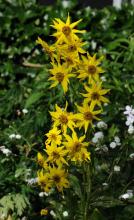
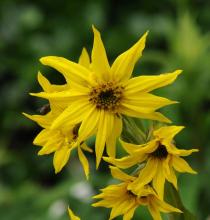
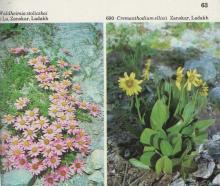
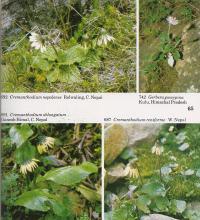
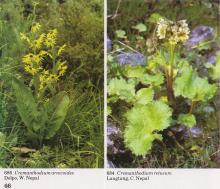
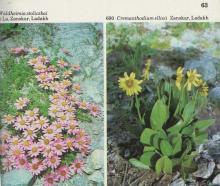
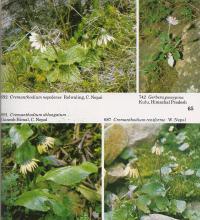
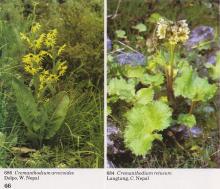
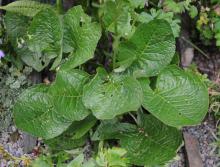
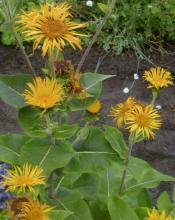
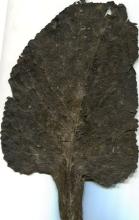
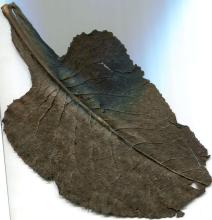
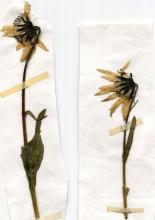
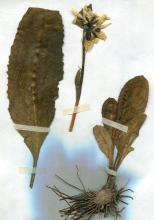
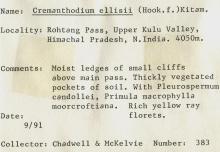
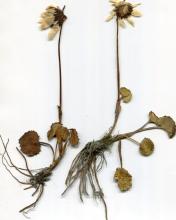
How tall is the plant? Are the flowers 'nodding?' Do you have any other photos? Maybe one closeup of the flower?